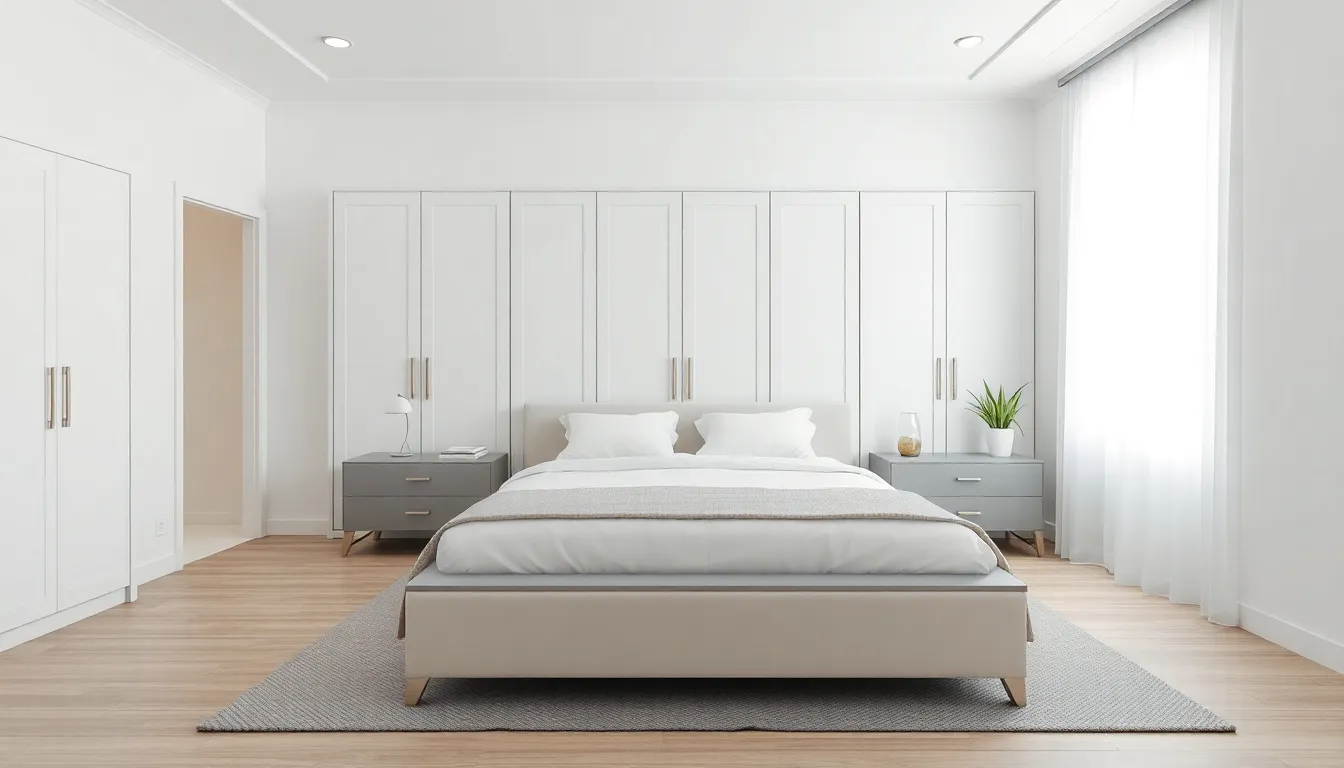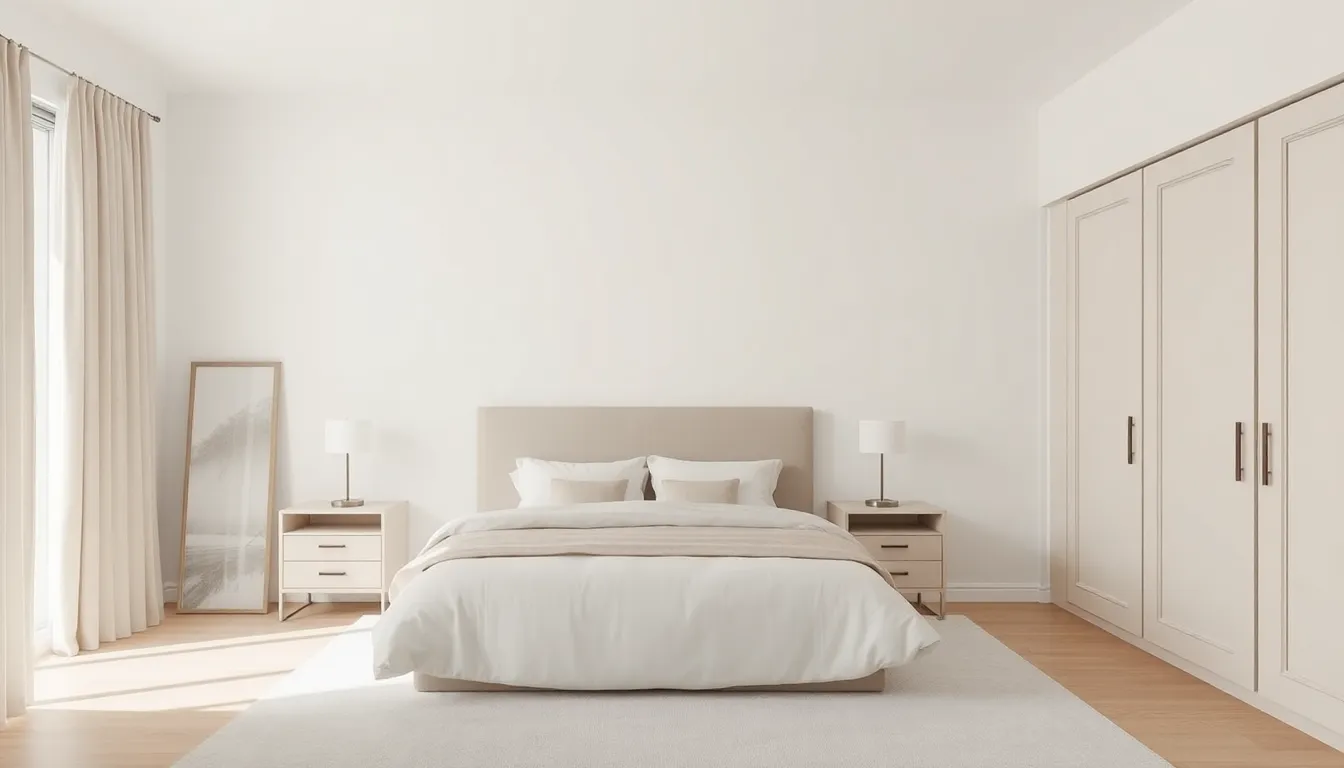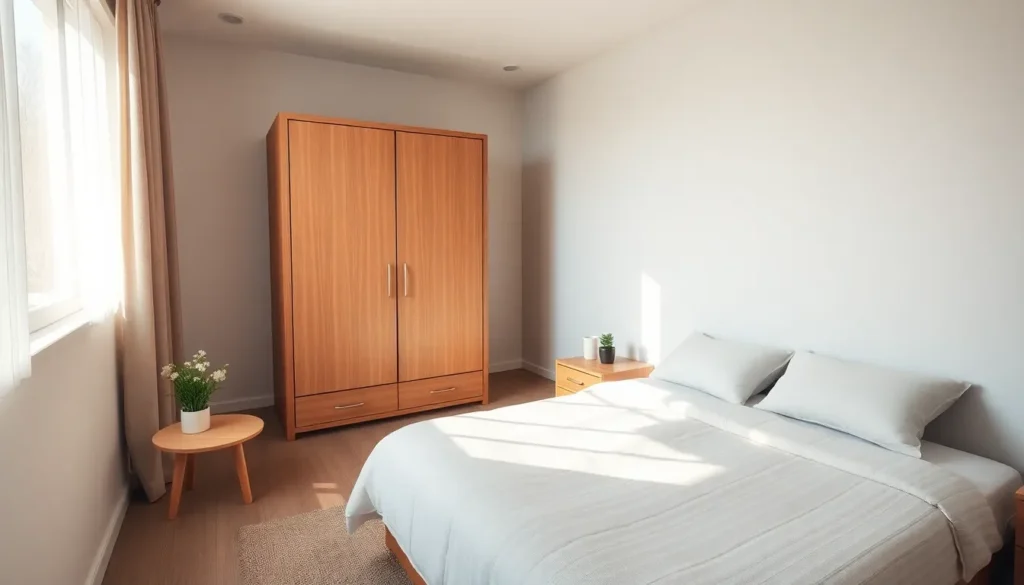In a world overflowing with clutter and chaos, the minimalist bedroom emerges as a serene sanctuary. Imagine stepping into a space that whispers tranquility instead of shouting for attention. With clean lines and a curated selection of essentials, minimalist design transforms a chaotic life into a peaceful retreat. It’s like hitting the reset button for your brain—who wouldn’t want that?
Table of Contents
ToggleWhat Is a Minimalist Bedroom?
A minimalist bedroom embodies simplicity, functionality, and tranquility. This space prioritizes essentials, removing clutter and distractions. Clean lines define furniture choices, while neutral color palettes promote a sense of calm. Storage solutions remain hidden, ensuring an organized appearance.
Minimalist design insists on the importance of thoughtful selections. Essential furniture includes a bed, bedside tables, and a wardrobe, each chosen for its utility and aesthetic appeal. Artwork and decor get limited, focusing on pieces that resonate with personal preferences without overwhelming the space.
Lighting plays a significant role in the minimalist bedroom. Natural light enhances openness, while soft, ambient lighting creates a cozy atmosphere during evenings. Window treatments should be simple, allowing sunlight to filter through while maintaining privacy.
Textiles contribute to comfort and warmth without cluttering the design. Bedding consists of quality materials, offering both elegance and coziness. Textured rugs and throws add depth without compromising minimalism, maintaining a balance between simplicity and invitingness.
Incorporating plants introduces life into the room, enhancing air quality and fostering a connection with nature. Careful placement ensures that greenery remains a focal point without overwhelming the decor. Thoughtful minimalism extends to personal items, with only a select few displayed to reflect personality while preserving visual clarity.
Ultimately, a minimalist bedroom serves as a sanctuary from daily chaos, creating an environment conducive to relaxation and mental clarity. Each design choice contributes to a cohesive feel, promoting a serene atmosphere essential for restorative sleep and peace of mind.
Key Features of Minimalist Bedrooms


Minimalist bedrooms prioritize simplicity and functionality, creating a peaceful atmosphere. Several key features contribute to this calming environment.
Simplified Color Palettes
Neutral color palettes dominate minimalist bedrooms, with whites, beiges, and grays providing a serene backdrop. These colors enhance natural light, making spaces feel larger and more inviting. Accents may introduce subtle variations, such as muted pastels or earthy tones, without overwhelming the simple design. Creating visual harmony, the systematic use of color promotes relaxation and encourages mental clarity.
Functional Furniture Choices
Essential furniture forms the backbone of minimalist bedrooms, focusing on utility. A bed serves as a central piece, emphasizing comfort while complementing other elements. Nightstands often feature sleek designs with integrated storage solutions that minimize clutter. Wardrobes are spacious yet unobtrusive, maintaining an organized appearance. Selecting practical items ensures the space remains tidy, reinforcing the minimalist philosophy of living with only what truly matters.
Benefits of a Minimalist Bedroom
A minimalist bedroom offers various advantages that enhance everyday living. They create a peaceful retreat, fostering both mental clarity and emotional well-being.
Enhanced Focus and Clarity
Minimalism promotes sharper concentration. By reducing visual clutter, individuals find it easier to concentrate on tasks at hand. Simplified surroundings limit distractions, leading to clearer thought processes. A minimalist bedroom acts as a blank slate that encourages creativity and mindfulness. Fewer objects mean less decision fatigue, resulting in improved mental clarity. Clean lines and neutral colors invoke tranquility, further supporting focused attention. This design choice emphasizes each piece’s purpose, ensuring that everything serves a function. Overall, a minimalist setting cultivates an environment where clarity thrives.
Reduced Stress and Anxiety
Simplicity in decor directly translates to reduced stress levels. Clutter generates feelings of overwhelm, while minimalism provides a sense of control. With essential items only, the space feels peaceful rather than chaotic. Individuals experience less pressure when navigating their surroundings. A well-organized environment nurtures calmness and reinforces emotional stability. Limited decor choices create a serene backdrop, minimizing distractions that contribute to anxiety. The intentional selection of furniture and accessories fosters comfort, emphasizing relaxation. In essence, a minimalist bedroom’s tranquil atmosphere serves as a sanctuary for rejuvenation and stress relief.
Tips for Designing a Minimalist Bedroom
Designing a minimalist bedroom requires intentional choices that enhance simplicity and tranquility. Exploring effective strategies can ensure a serene and organized space.
Decluttering Strategies
Decluttering sets the foundation for a minimalist bedroom. Start by assessing belongings and removing items that serve no purpose. Prioritize functionality over aesthetics while choosing essentials. Donate or discard items that haven’t been used in over six months. Organizing remaining items in designated spaces promotes neatness. Store seasonal clothing in under-bed boxes to maximize space. Consider using multifunctional furniture, such as a bed with built-in storage, to minimize excess. Aim for a clean and open feel that supports relaxation and mental clarity.
Choosing the Right Decor
Choosing decor in a minimalist bedroom emphasizes simplicity and personal connection. Begin with a neutral color palette to create a calming atmosphere. Select a few art pieces that resonate personally, allowing for self-expression without overwhelming the space. Limit decorative pillows and accessories to maintain open surfaces. Ensure that textiles, like bedding and rugs, provide comfort while complementing the overall aesthetic. Incorporating a single plant as a focal point can introduce life while aligning with minimalist principles. Emphasize quality over quantity in your decor selections for a cohesive and serene environment.



